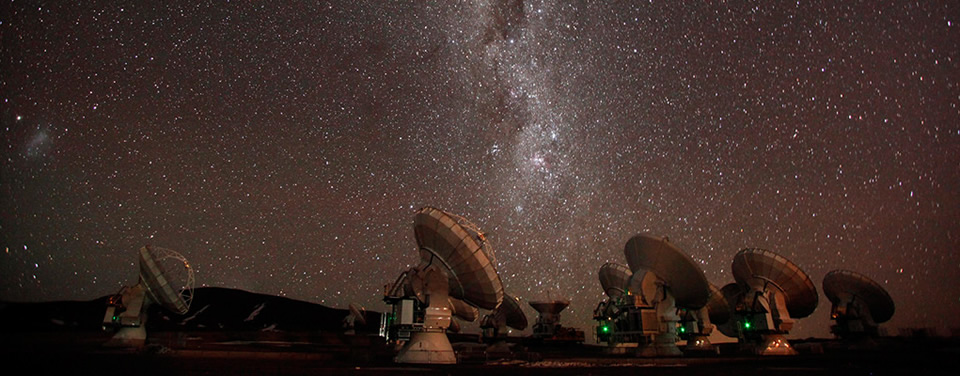About ALMA, at first glance
In the Chajnantor Plateau in the Atacama Desert, one of the highest and driest places on Earth, a gentle “rain” is falling. It is light from space, in millimetric and submillimetric wavelengths, a natural, scarce and precious resource. It is well-known that these waves are full of information about our cosmic origins, that is why people thirsty for this knowledge have gathered here to collect, channel and analyze it.
This is what gives rise to the Atacama Large Millimeter/submillimeter Array (ALMA), currently the most powerful radio telescope on Earth. This achievement is the result of an international association between Europe (ESO), North America (NRAO) and East Asia (NAOJ), in collaboration with the Republic of Chile, to build the observatory of the “Dark Universe”.
The light in these millimetric and submillimetric wavelengths comes from vast cold clouds in space, at temperatures of just a few dozen degrees above absolute zero (-273oC), and from some of the earliest and furthest galaxies in our Universe. Astronomers can use this light to study the chemical and physical conditions in these molecular clouds, which are dense regions of gas and dust where new stars are forming. These regions of the Universe are often dark and remain hidden from the visible range of light, but they shine intensely in the millimetric and submillimetric part of the spectrum.
This radio telescope is composed of 66 high-precision antennas, which operate on wavelengths of 0.32 to 3.6 mm. Its main array has fifty antennas, each with 12-meter diameters, which act together as a single telescope: an interferometer. This is complemented by a compact array of four antennas with 12-meter diameters and 12 antennas with 7-meter diameters. ALMA’s antennas can be configured in different ways, spacing them at distances from 150 meters to 16 kilometers, giving ALMA a powerful “zoom” variable, which results in images clearer than the images from the Hubble Space Telescope.
ALMA is already “irrigating” the fields of astronomy in depth, 24 hours a day, 365 days a year. Scientists foresee record harvests, where invisible light (radio waves) accumulated by ALMA will be vital to our understanding of the Universe. The purpose of ALMA is to study star formation, molecular clouds and the early Universe, closing in on its main objective: discovering our cosmic origins.
The movie ALMA — In Search of our Cosmic Origins This 16-minute video presents the history of ALMA from the origins of the project several decades ago to the recent first science results. Illustrated by dramatic helicopter footage, the movie takes you on a journey to the 5000-metre-high Chajnantor Plateau, where ALMA stands, in the unique environment of the Atacama Desert of Chile.
Credit: ALMA (ESO/NAOJ/NRAO)
Directed by: Lars Lindberg Christensen. Art Direction, Production Design: Martin Kornmesser. Producer: Herbert Zodet. Written by: Nicola Guttridge, Gara Mora-Carillo, Douglas Pierce-Price and Herbert Zodet. 3D Animations and Graphics: Martin Kornmesser and Luis Calçada. Editing: Martin Kornmesser. Cinematography: Herbert Zodet Music: Toomas Erm. Narration: Sara Mendes da Costa. Web and technical support: Mathias André and Raquel Yumi Shida. Proof Reading: Anne Rhodes. Visuals: ESO, ALMA (ESO/NAOJ/NRAO), C. Malin (cristophmalin.com), José Francisco Salgado (josefrancisco.org), B. Tafreshi (twanight.org), NRAO/General Dynamics C4 Systems, NRAO/AUI/NSF, Al Wootten, Y. Beletsky, Nick Risinger (skysurvey.org), S. Guisard (eso.org/~sguisard), NASA/JPL-Caltech/WISE Team, M. Maercker et al, the NASA/ESA Hubble Space Telescope. Executive Producer: Lars Lindberg Christensen.
